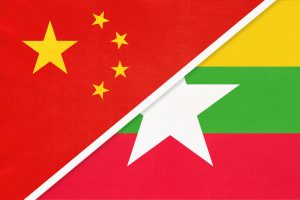An alliance of armed resistance groups in Myanmar has seized another major border crossing on the country’s northeastern border with China, a month after launching a coordinated offensive against the military junta.
An offensive by the Myanmar National Democratic Alliance Army (MNDAA), part of the Three Brotherhood Alliance, captured the Kyin San Kyawt border gate, MNDAA officials and MNDAA-affiliated media outlets said.
“MNDAA also reported they seized one more border trade gate, which is called Kyin San Kyawt, in Mongko area, Muse district this morning,” the Kokang News reported Sunday, according to the AFP news agency.
Kyin San Kyawt is the fourth border crossing seized by the resistance forces since the launch of a coordinated offensive on October 27.
Operation 1027, as it has been dubbed, has seen dramatic gains by the Three Brotherhood Alliance, which in addition to the MNDAA also includes the Arakan Army and Ta’ang National Liberation Army. Alliance forces, spearheaded by the MNDAA, have since overrun more than 200 military outposts across northern Shan State, dealing the military junta the biggest setback since it seized power in a coup in February 2021.
The Kyin San Kyawt border gate, a busy conduit for the import of goods including machinery, electrical appliances, agricultural tools, and consumer products and the export of agricultural produce, is one of the five major trading gates in Muse township, which hosts the 105-Mile Trade Zone and is the country’s main portal of trade with China.
Two of these border crossings are now under the control of the MNDAA, along with two others along other parts of the border, including the border crossing of Chinshwehaw in Laukkai township further to the east.
The resulting fighting has displaced tens of thousands of civilians across the northern part of Shan State, particularly from Laukkai, the capital of the junta-aligned Kokang Self-Administered Zone (SAZ), where thousands have been forced to flee as Alliance forces close in. It has also stopped most official cross-border trade with China, intensifying the economic pressures on the military administration in Naypyidaw.
On Friday, the military junta admitted that a convoy of roughly 120 trucks bringing goods into Myanmar from China was burned in Muse township by what it termed “terrorist” actors.
“About 120 out of 258 vehicles carrying household goods, consumer goods, clothes, and building materials were destroyed by fire,” the state-run Global New Light of Myanmar newspaper reported. An MNDAA spokesperson denied responsibility for the attack.
China has reacted to these developments by again calling for stability and calm and taking measures to ensure that the instability in the northern Shan State does not spill across its own border, or endanger Chinese nationals. On Saturday, a day after the convoy trucks went up in flames in Muse, and the same day that the Kyin San Kyawt border gate fell to the MNDAA, China’s military announced that it was beginning “combat training activities” along the border.
According to a Reuters report that cited the army newspaper PLA Daily, the live-fire drills are aimed at “testing the mobility, border control abilities, and firepower capabilities of the military units so that the People’s Liberation Army is ready for any emergency.”
Chinese authorities near Laukkai have also reportedly stopped displaced civilians from trying to seek refuge over the Chinese border. Videos circulated on social media that appeared to show Chinese police firing tear gas at people who were sheltering close to the border fence on the eastern side of Laukkai, reports that local residents have since confirmed.
Despite these muscular responses, it is notable that China, which boasts long-standing relationships with the MNDAA and the other armed groups along its border with Myanmar, has done little to use this influence to bring Operation 1027 to an end. The likely reason is Beijing’s growing frustration with the criminal enterprises that have flourished under the control of the junta-aligned Border Guard Force (BGF) that has ruled the Kokang SAZ since 2009, when the Myanmar army drove the MNDAA out of the region.
Under the BGF, Laukkai has become particularly notorious for hosting cyberscam operations controlled by Chinese crime families, which have ensnared countless Chinese nationals, both as victims and as trafficked perpetrators. Attuned to Beijing’s frustration, the MNDAA has made common cause with Beijing by declaring the elimination of Laukkai’s cyberscam centers as one of the main goals of Operation 1027.
China’s self-interested policy has prompted some rare outward signs of tension in the relationship between Naypyidaw and Beijing. Last week, several dozen “Myanmar regime-backed nationalists,” as The Irrawaddy characterized them, gathered outside the Chinese embassy in Yangon, Myanmar’s commercial capital, to protest China’s apparent support for Operation 1027.
From City Hall, protesters marched to the Chinese Embassy shouting anti-China slogans including, “China, you have been meddling in the internal affairs of Myanmar. Don’t try to exploit us. We monks and people are gonna beat you up.”
As The Irrawaddy noted, this was “the first time China has been named openly in a public, junta-approved protest targeting Beijing, the Myanmar regime’s ally.”

































